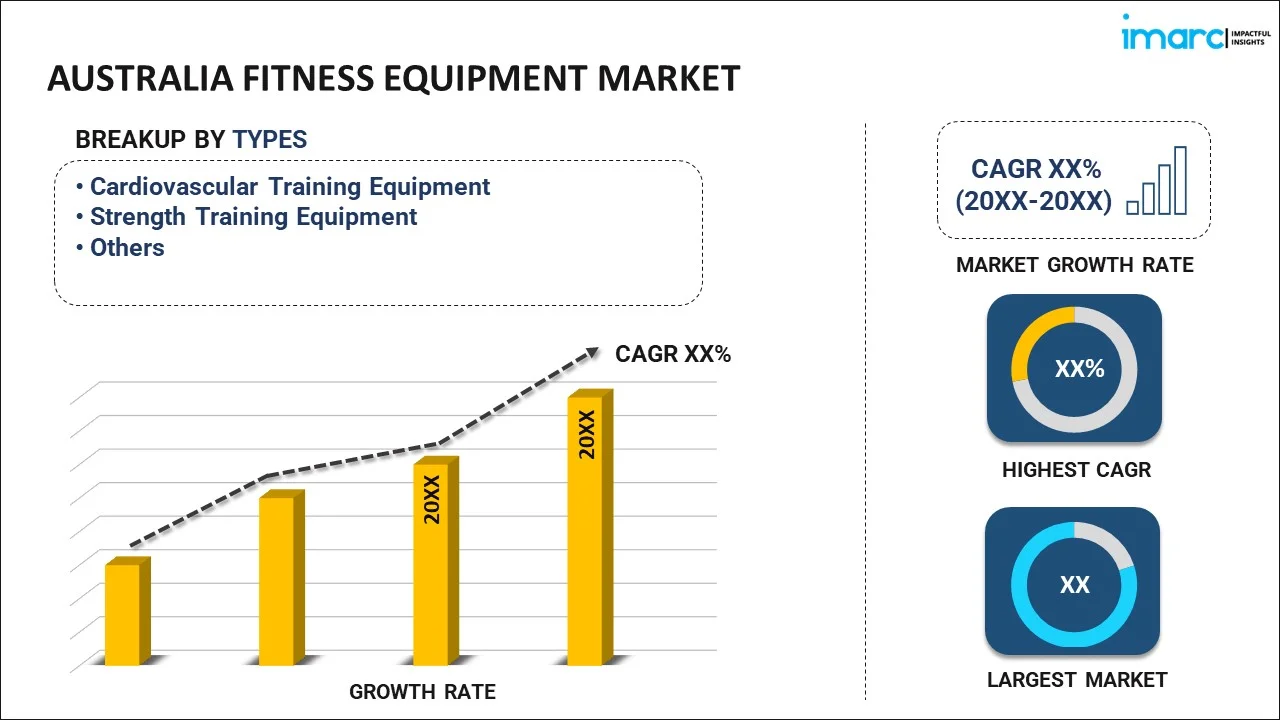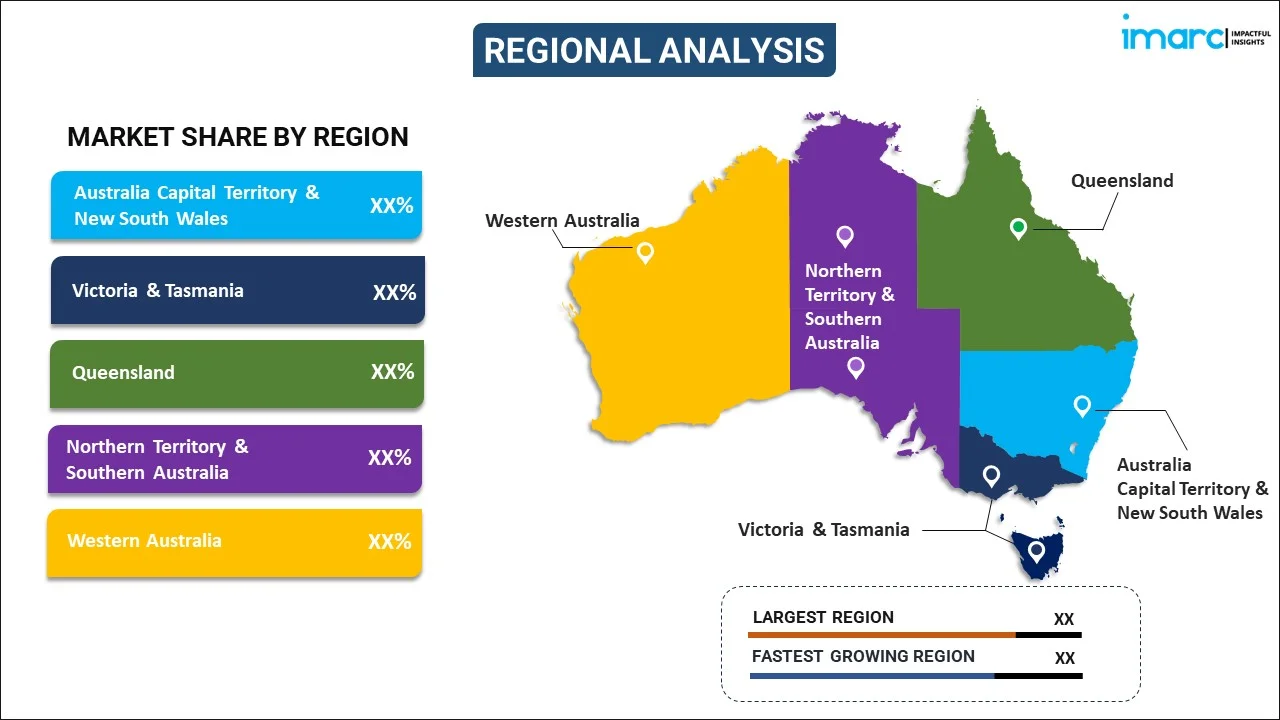
Australia Fitness Equipment Market Report by Type (Cardiovascular Training Equipment, Strength Training Equipment, and Others), Price Point (Standard, Premium/Luxury), End User (Home Consumer, Health Clubs/Gym, and Others), and Region 2025-2033
Market Overview:
Australia fitness equipment market size is projected to exhibit a growth rate (CAGR) of 7.13% during 2025-2033. The rising integration of software-based coaching solutions that can monitor the amount of weight lifted, range of motion, number of sets and reps, etc., is primarily driving the market growth.
|
Report Attribute
|
Key Statistics
|
|---|---|
|
Base Year
|
2024 |
|
Forecast Years
|
2025-2033 |
|
Historical Years
|
2019-2024
|
| Market Growth Rate (2025-2033) | 7.13% |
Fitness equipment refers to a diverse array of specialized tools and devices designed for physical exercise, training, and overall health improvement. They are made to facilitate various aspects of fitness, catering to cardiovascular endurance, strength building, flexibility, wellness, etc. Some of the common fitness devices include treadmills, stationary bicycles, elliptical trainers, resistance machines, free weights, yoga mats, etc. Treadmills and stationary bikes focus on cardiovascular health, while resistance machines and free weights target muscle strength and endurance. Elliptical trainers provide a low-impact full-body workout. These tools are utilized in gyms, fitness studios, and home setups to create comprehensive exercise routines. Fitness equipment plays a crucial role in helping individuals to achieve their fitness goals, thereby promoting an active and healthy lifestyle.
Australia Fitness Equipment Market Trends:
The Australia fitness equipment market is experiencing robust growth, propelled by a convergence of influential factors. Firstly, the escalating health and wellness awareness among individuals serves as a primary driver, prompting the demand for fitness equipment that facilitates home-based workouts and exercise routines. Besides this, as consumers prioritize their well-being, the market across Australia witnesses a surge in purchases of diverse fitness tools. Moreover, the changing lifestyle patterns, including the preference for convenience and flexibility in workout regimes, contribute significantly to the market dynamics. Apart from this, individuals are also embracing home fitness solutions, fostering the demand for compact and multifunctional fitness equipment that caters to diverse exercise needs. Additionally, technological advancements play a pivotal role in shaping the Australia fitness equipment market. In line with this, the elevating integration of smart features, such as fitness trackers and connectivity options, enhances the appeal of these products, resonating with tech-savvy consumers seeking an interactive and data-driven fitness experience. Furthermore, the shifting consumer preferences towards home-based workouts are anticipated to fuel the market growth across the country in the coming years.
Australia Fitness Equipment Market Segmentation:
IMARC Group provides an analysis of the key trends in each segment of the market, along with forecasts at the country level for 2025-2033. Our report has categorized the market based on type, price point, and end user.
Type Insights:

- Cardiovascular Training Equipment
- Treadmills
- Stationary Cycles
- Elliptical
- Others
- Strength Training Equipment
- Free Weights
- Others
- Others
The report has provided a detailed breakup and analysis of the market based on the type. This includes cardiovascular training equipment (treadmills, stationary cycles, elliptical, and others), strength training equipment (free weights, and others), and others.
Price Point Insights:
- Standard
- Premium/Luxury
A detailed breakup and analysis of the market based on the price point have also been provided in the report. This includes standard and premium/luxury.
End User Insights:
- Home Consumer
- Home
- Apartment
- Health Clubs/Gym
- Others
The report has provided a detailed breakup and analysis of the market based on the end user. This includes home consumer (home and apartment), health clubs/gym, and others.
Regional Insights:

- Australia Capital Territory & New South Wales
- Victoria & Tasmania
- Queensland
- Northern Territory & Southern Australia
- Western Australia
The report has also provided a comprehensive analysis of all the major regional markets, which include Australia Capital Territory & New South Wales, Victoria & Tasmania, Queensland, Northern Territory & Southern Australia, and Western Australia.
Competitive Landscape:
The market research report has also provided a comprehensive analysis of the competitive landscape in the market. Competitive analysis such as market structure, key player positioning, top winning strategies, competitive dashboard, and company evaluation quadrant has been covered in the report. Also, detailed profiles of all major companies have been provided.
Australia Fitness Equipment Market Report Coverage:
| Report Features | Details |
|---|---|
| Base Year of the Analysis | 2024 |
| Historical Period | 2019-2024 |
| Forecast Period | 2025-2033 |
| Units | Million USD |
| Scope of the Report | Exploration of Historical Trends and Market Outlook, Industry Catalysts and Challenges, Segment-Wise Historical and Future Market Assessment:
|
| Types Covered |
|
| Price Points Covered | Standard, Premium/Luxury |
| End Users Covered |
|
| Regions Covered | Australia Capital Territory & New South Wales, Victoria & Tasmania, Queensland, Northern Territory & Southern Australia, Western Australia |
| Customization Scope | 10% Free Customization |
| Post-Sale Analyst Support | 10-12 Weeks |
| Delivery Format | PDF and Excel through Email (We can also provide the editable version of the report in PPT/Word format on special request) |
Key Questions Answered in This Report:
- How has the Australia fitness equipment market performed so far and how will it perform in the coming years?
- What has been the impact of COVID-19 on the Australia fitness equipment market?
- What is the breakup of the Australia fitness equipment market on the basis of type?
- What is the breakup of the Australia fitness equipment market on the basis of price point?
- What is the breakup of the Australia fitness equipment market on the basis of end user?
- What are the various stages in the value chain of the Australia fitness equipment market?
- What are the key driving factors and challenges in the Australia fitness equipment?
- What is the structure of the Australia fitness equipment market and who are the key players?
- What is the degree of competition in the Australia fitness equipment market?
Key Benefits for Stakeholders:
- IMARC’s industry report offers a comprehensive quantitative analysis of various market segments, historical and current market trends, market forecasts, and dynamics of the Australia fitness equipment market from 2019-2033.
- The research report provides the latest information on the market drivers, challenges, and opportunities in the Australia fitness equipment market.
- Porter's five forces analysis assist stakeholders in assessing the impact of new entrants, competitive rivalry, supplier power, buyer power, and the threat of substitution. It helps stakeholders to analyze the level of competition within the Australia fitness equipment industry and its attractiveness.
- Competitive landscape allows stakeholders to understand their competitive environment and provides an insight into the current positions of key players in the market.
Need more help?
- Speak to our experienced analysts for insights on the current market scenarios.
- Include additional segments and countries to customize the report as per your requirement.
- Gain an unparalleled competitive advantage in your domain by understanding how to utilize the report and positively impacting your operations and revenue.
- For further assistance, please connect with our analysts.
 Inquire Before Buying
Inquire Before Buying
 Speak to an Analyst
Speak to an Analyst
 Request Brochure
Request Brochure
 Request Customization
Request Customization




.webp)




.webp)












